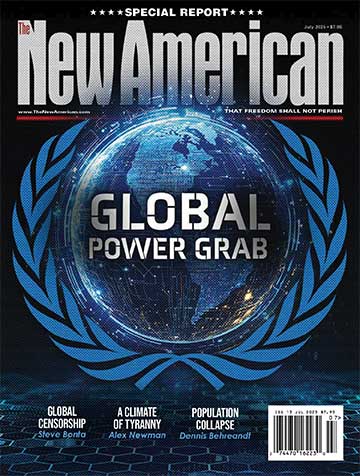
Is methane an even worse climate villain than CO2? In the run-up to this year’s UN Paris Summit on global warming, President Obama, radical NGOs, and professional alarmists in the media are hyping the “threat” that methane (CH4) supposedly presents to the planet.
In January, President Obama announced plans for new EPA mandates aimed at cutting methane emissions by nearly one-half over the next decade. Hence, the federal regulators are busily crafting and ordering new limits on emissions from cows and other gassy critters, manure piles, landfills, sewers, and motor vehicles, etc. But the main targets, of course, are the coal, oil, and natural-gas industries. Coal and oil, especially, have been in the crosshairs, while, until recently, natural gas was the darling of environmentalists, who promoted it as the “clean energy” alternative to its “dirty” hydrocarbon cousins. However, now that natural-gas production has taken off and is actually replacing significant amounts of coal and oil, its erstwhile champions have turned on it with a vengeance.
“We have to control methane immediately, and natural gas is the largest methane pollution source in the United States,” says Cornell University marine biologist Robert Howarth, who claims that human-caused methane production, if not forcibly curtailed, will push Earth’s temperature beyond the point of no return. “If we hit a climate-system tipping point because of methane, our carbon dioxide problem is immaterial. We have to get a handle on methane, or increasingly risk global catastrophe.”
For global-warming alarmists, carbon dioxide is the demon greenhouse gas (GHG) nonpareil. We have been harangued incessantly for more than two decades with claims that our use of fossil fuels is increasing the earth’s atmospheric CO2 levels to such an extent that it will bring on catastrophic global warming. But the CO2-as-demon narrative has been in need of assistance, as top scientists such as MIT’s Richard Lindzen, University of Melbourne’s Ian Plimer, Colorado State University’s Roger Pielke, Princeton University’s William Happer, the University of Connecticut’s Howard Hayden, and Dr. Sherwood B. Idso of the Center for the Study of Carbon Dioxide and Global Change — to name but a few — have shredded the claims that manmade CO2 is a danger to humankind or the planet. They point out, among other things, that:
1) Despite the EPA’s false classification of CO2 as a pollutant, it is a beneficial gas that is essential for life on earth;
2) We are actually in a “CO2 famine,” as compared to many periods of Earth’s history when CO2 levels have been much higher, with no negative consequences;
3) The historical record plays havoc with the alarmists’ cause-and-effect narrative, showing that climate changes precede CO2 changes, making it impossible for CO2 to be responsible for alleged global warming;
4) Anthropogenic (manmade) CO2 is a minuscule 3-4 percent of Earth’s atmospheric CO2;
5) As CO2 levels have continued to rise, global atmospheric temperatures have failed to rise for the past 18 years;
6) The real, observed temperature record disproves all the widely touted alarmist computer models of CO2 “forcing.”
But CO2 is not the only GHG demon; methane (CH4) may be an even bigger climate villain, the alarmists now say. Belching cows, flatulent sheep, ocean “burps,” thawing permafrost, and mysterious “black holes” in Siberia are emitting “dangerous” levels of the stinky gas, we are told. These are not new claims; they have been bubbling in alarmist circles for years. The New York Times article, “Greening the Herds: A New Diet to Cap Gas” in 2009 and Newsweek’s “Putting an End to Gassy Cows” are typical examples of the “methane crisis” stories.
Robert Howarth’s study, “A Bridge to Nowhere: Methane Emissions and the Greenhouse Gas Footprint of Natural Gas,” published May 20, 2014 in the journal Energy Science and Engineering, gave the methane scare a much-needed boost. Cornell’s media relations office pumped it up with a press release that was widely parroted by the usual media accomplices. “As the shale gas boom continues, the atmosphere receives more methane, adding to Earth’s greenhouse gas problem,” the Cornell publicity office declared. “Robert Howarth, greenhouse gas expert and ecology and environmental biology professor, fears that we may not be many years away from an environmental tipping point — and disaster.”
The Cornell press release continued:
“We have to control methane immediately, and natural gas is the largest methane pollution source in the United States,” said Howarth…. Natural gas — that once seemingly promising link between the era of oil and coal to the serenity of sustainable solar, wind and water power — is a major source of atmospheric methane, due to widespread leaks as well as purposeful venting of gas. Howarth points to “radiative forcing,” a measure of trapped heat in Earth’s atmosphere from man-made greenhouse gases. The current role of methane looms large, he says, contributing over 40 percent of current radiative forcing from all greenhouse gases, based on the latest science from the Intergovernmental Panel on Climate Change.
This was a repeat performance by Howarth, who started on his road to fame (or infamy) with similar claims in an article in Climate Change Letters in 2011. Not surprisingly, the New York Times jumped on Howarth’s bandwagon, launching him into climate rock star status alongside Al Gore and Michael Mann (of the “Hockey Stick” graph infamy). Unfortunately for Howarth (and the Times), his “science” has been as thoroughly discredited as the Gore-Mann climate diatribes. Howarth’s “research” has been taken apart not only by scientists in the global-warming “skeptical” camp, but, as Jon Entine points out at Forbes, also by high-powered greenies at Environmental Defense Fund, the Natural Resources Defense Council, the Council on Foreign Relations, and the U.S. Energy Department, as well as other prominent academic researchers.
Howarth’s claims were especially eviscerated by Professors Lawrence M. Cathles, Larry Brown, and Andrew Hunter, all of Cornell, and Milton Taam of Electronic Software, Inc. in an article for the January 3, 2012 issue of Climatic Change. Unlike Howarth, Professor Cathles (of Cornell’s Department of Earth and Atmospheric Sciences) and his colleagues are experts in the field that Howarth is attempting to co-opt.
Another important study on the natural gas-methane matter came out in the August 5, 2011 issue of Environmental Research Letters by scientists at Carnegie Mellon University.
As to be expected, the major MSM outlets have opted for Howarth’s sensational “global catastrophe” story over the more rational, credible research that contradicted his claim. George Mason University professor Robert Lichter found that, by a ratio of 12 to 1, major media organs promoted the anti-fracking Howarth study while ignoring the Carnegie Mellon study showing the relatively benign impact of natural gas development.
Likewise, the MSM alarmist choir has almost totally ignored Howarth’s ties to funding from the radical Park Foundation, as exposed last year in a report by the Republican minority of the Senate Environment and Public Works Committee entitled, “The Chain of Environmental Command: How a Club of Billionaires and Their Foundations Control the Environmental Movement and Obama’s EPA.”
The Senate report found the Park Foundation had showered hundreds of thousands of dollars on Howarth’s research, as well as many of the “alternative media” that hyped his claims. According to “The Chain of Environmental Command”:
Since the spring 2011 study, Cornell’s Park-funded anti-fracking efforts have received extensive attention from Park-linked far-left environmental media sources. Park funded news outlets such as Earth Island Journal (who received $31,500 from Park between 2010 and 2012) and Yes! magazine (who received $50,000 from Park between 2010 and 2012) supported and defended Howarth and his Cornell study. In fact in January 2012, long after the controversy erupted, an article in Yes! attacking fracking in the Marcellus Shale admiringly referred to Howarth as “co-author of last year’s landmark Cornell University study, which established the staggering greenhouse-gas footprint of fracking.” This is but one discreet example of the manufactured echo chamber.
That echo chamber similarly ignored a very important admission against interest by the same UN Intergovernmental Panel on Climate Change (IPCC) that Howarth cited as his authority. Meteorologist Anthony Watts of the always-helpful website WattsUpWithThat.com has posted a graph from the IPCC’s own latest assessment (AR5) showing the huge gulf between the exaggerated computer-projected methane emissions and the real, measured global methane emissions. As usual, the computer models were/are spectacularly wrong. (See here and here for more on the repeated failure of the global-warming computer models.)
Methane: “The Irrelevant Greenhouse Gas”
According to physicist Thomas P. Sheahen, methane is, really, “the irrelevant greenhouse gas.”
“Fortunately, there is really nothing to worry about, scientifically,” Sheahen says. “The main thing to worry about is over-reacting politicians and another layer of unnecessary government regulations.”
In a brilliant guest essay at WattsUpWithThat, Dr. Sheahen explains in laymen’s terms the absorption of sunlight by the various greenhouse gases in the Earth’s atmosphere, according to wavelength bands. “Because water vapor … is much more plentiful in the atmosphere than any of the others, H2O absorbs vastly more energy and is by far the most important greenhouse gas,” he notes. While water vapor accounts for one to two percent of the atmosphere on any given day, “CO2 is only about 0.04% of the atmosphere (400 parts per million), so it’s much less important than water vapor.”
Methane (CH4), Dr. Sheahen points out, has narrow absorption bands at 3.3 microns and 7.5 microns. It is, he concedes, “20 times more effective an absorber than CO2 — in those bands. However, CH4 is only 0.00017% (1.7 parts per million) of the atmosphere. Moreover, both of its bands occur at wavelengths where H2O is already absorbing substantially. Hence, any radiation that CH4 might absorb has already been absorbed by H2O. The ratio of the percentages of water to methane is such that the effects of CH4 are completely masked by H2O. The amount of CH4 must increase 100-fold to make it comparable to H2O.”
“Because of that, methane is irrelevant as a greenhouse gas,” he notes. “The high per-molecule absorption cross section of CH4 makes no difference at all in our real atmosphere.”
“Unfortunately, this numerical reality is overlooked by most people,” says Sheahen. “There is a lot of misinformation floating around, causing needless worry. The tiny increases in methane associated with cows may elicit a few giggles, but it absolutely cannot be the basis for sane regulations or national policy.”
Related articles:
President Unveils Plan to Eviscerate Energy Boom With Methane Mandates
EPA: Time to Abolish, Not Merely Restrict
Report Details Close Relationship Between EPA and Green Groups
Obama’s EPA Coal Plant Regulations: “Obamacare for the Atmosphere”
Global Conning: Temperature Data Cooked in “Biggest Science Scandal Ever”
Now Hiring Rent-A-Mobs: Mobilizing Global Warming Activists for 2015 Action
Lawless “Billionaire Club” Behind Green Scam, Senate Study Finds




